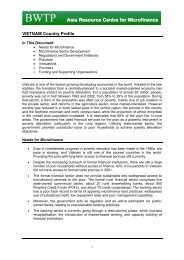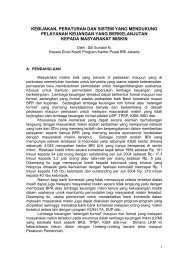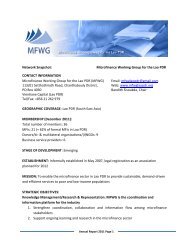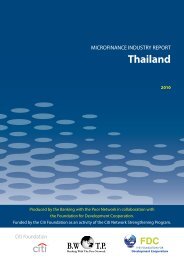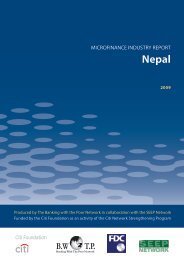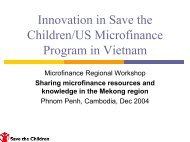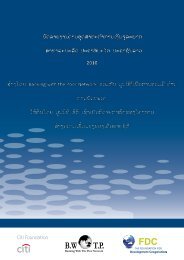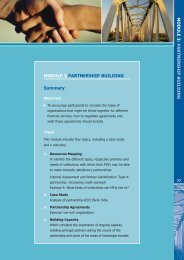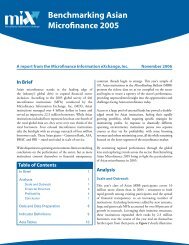microfinance industry report - Vietnam - Banking with the Poor Network
microfinance industry report - Vietnam - Banking with the Poor Network
microfinance industry report - Vietnam - Banking with the Poor Network
You also want an ePaper? Increase the reach of your titles
YUMPU automatically turns print PDFs into web optimized ePapers that Google loves.
5. Funding Sources<br />
There are some donor and funding agencies<br />
supporting <strong>microfinance</strong> in Viet Nam, but most<br />
funding is made available to support rural credit<br />
and SME development. The key donors are Asian<br />
Development Bank, World Bank, KfW/GtZ, AFD,<br />
AusAid, Ford Foundation, CIDA, and <strong>the</strong> Belgian<br />
Directorate-General for Development Cooperation<br />
(DGDC) 67 . The lack of a conducive enabling<br />
environment has essentially discouraged large<br />
amounts of donor funding to support <strong>microfinance</strong><br />
activities provided by semi-formal organizations.<br />
The government has contributed capital to all of<br />
<strong>the</strong> formal financial service providers serving BOP.<br />
In addition, international donors have allocated<br />
significant amounts of credit to <strong>the</strong> banking sector<br />
for on-lending to SMEs and individuals. The SOCBs<br />
and some JSCBs have access to donor credit lines<br />
ei<strong>the</strong>r directly, through specialized units such as<br />
<strong>the</strong> Transaction Center III (of BIDV which functions<br />
entirely as an intermediary of World Bank credit),<br />
or through donor-funded projects such as <strong>the</strong> EUfunded<br />
SMEPF. Policy lenders (VBSP and VDB) access<br />
budget funds and ODA credit and so does CCF, <strong>the</strong><br />
apex institution which on-lends to <strong>the</strong> PCFs.<br />
The key rationale for external credit infusion into<br />
<strong>the</strong> formal banking system is <strong>the</strong> lack of long-term<br />
credit financing. The directed donor credit lines for<br />
<strong>the</strong> rural and/or poor market segments provided<br />
by ADB, World Bank, and AFD via MOF and BIDV<br />
(and by KfW via MOLISA) to VBARD all require <strong>the</strong><br />
borrowing institution to serve a low-income market<br />
segment. By contrast, <strong>the</strong> competitively awarded<br />
EU credit provided through <strong>the</strong> SMEDF located<br />
appears to apply a more demand-driven approach.<br />
However, it is questionable whe<strong>the</strong>r <strong>the</strong> TA provided<br />
to complement <strong>the</strong> credit lines has been successful<br />
enough to entice <strong>the</strong> recipient banks to take over<br />
and continue <strong>the</strong> lending to SMEs or <strong>the</strong> rural poor<br />
using <strong>the</strong>ir own resources. Moreover, <strong>the</strong>re does<br />
not seem to be any clear exit strategy among <strong>the</strong><br />
larger donors concerning <strong>the</strong> future provision of<br />
credit lines and in many cases few demands on <strong>the</strong><br />
recipient banks to allocate own funds and share <strong>the</strong><br />
risk of investments.<br />
The Microfinance Loan Fund (MLF) under <strong>the</strong> 2nd<br />
Rural Finance Project of <strong>the</strong> World Bank, instituted in<br />
2002, allocated $28 million for lending to Microfinance<br />
Institutions including commercial and Joint Stock<br />
banks, credit cooperatives, PCFs and credit-granting<br />
NGOs accredited by <strong>the</strong> BIDV as <strong>the</strong> implementing<br />
agency. However, by 2006, 95% of <strong>the</strong> credit funds<br />
allocated through <strong>the</strong> o<strong>the</strong>rwise well-designed MLF<br />
had been channeled through VBARD, and no PCF<br />
nor any semi-formal MFO was accredited for access<br />
to loan capital or <strong>the</strong> institutional streng<strong>the</strong>ning<br />
envisaged under <strong>the</strong> program. The follow-on 3rd<br />
Rural Finance Project approved in May 2008 allocates<br />
$10 million ($5 million from IDA) to increase rural<br />
poor access to <strong>microfinance</strong>, but <strong>the</strong> operating<br />
system is not changed, so it remains questionable<br />
whe<strong>the</strong>r PCFs or NGOs can access funds until <strong>the</strong>y<br />
are licensed following <strong>the</strong> implementation of Decree<br />
28/165.<br />
In addition, <strong>the</strong> First Initiative funded <strong>the</strong> formation<br />
of a Peoples Credit Fund (PCF) association in 2005 to<br />
streng<strong>the</strong>n <strong>the</strong> cohesiveness of <strong>the</strong> PCF network and<br />
provide a more stable and effective financial system<br />
for <strong>the</strong> poor. The main purpose of this project is to<br />
support <strong>the</strong> development of <strong>the</strong> PCF Association,<br />
whose main role will be to advise and assist its<br />
member PCFs by providing a service that will enable<br />
PCFs to serve <strong>the</strong>ir customers. Project costs total<br />
$360,000. 68<br />
68 For more information, refer to http://www.firstinitiative.org/<br />
Projects/projectdisplay.cfm?iProjectID=390<br />
67 For an overview of existing donor funding to <strong>the</strong> financial sector,<br />
see Financial Sector Assistance Projects in Viet Nam: Financial<br />
Sector Donor Working Group: “Active Projects as of November<br />
2007”.<br />
<strong>Banking</strong> With The <strong>Poor</strong> <strong>Network</strong> 37<br />
<strong>Vietnam</strong>e_Report_FOR_PRINT.indd 37<br />
27/05/2009 7:46:03 PM



